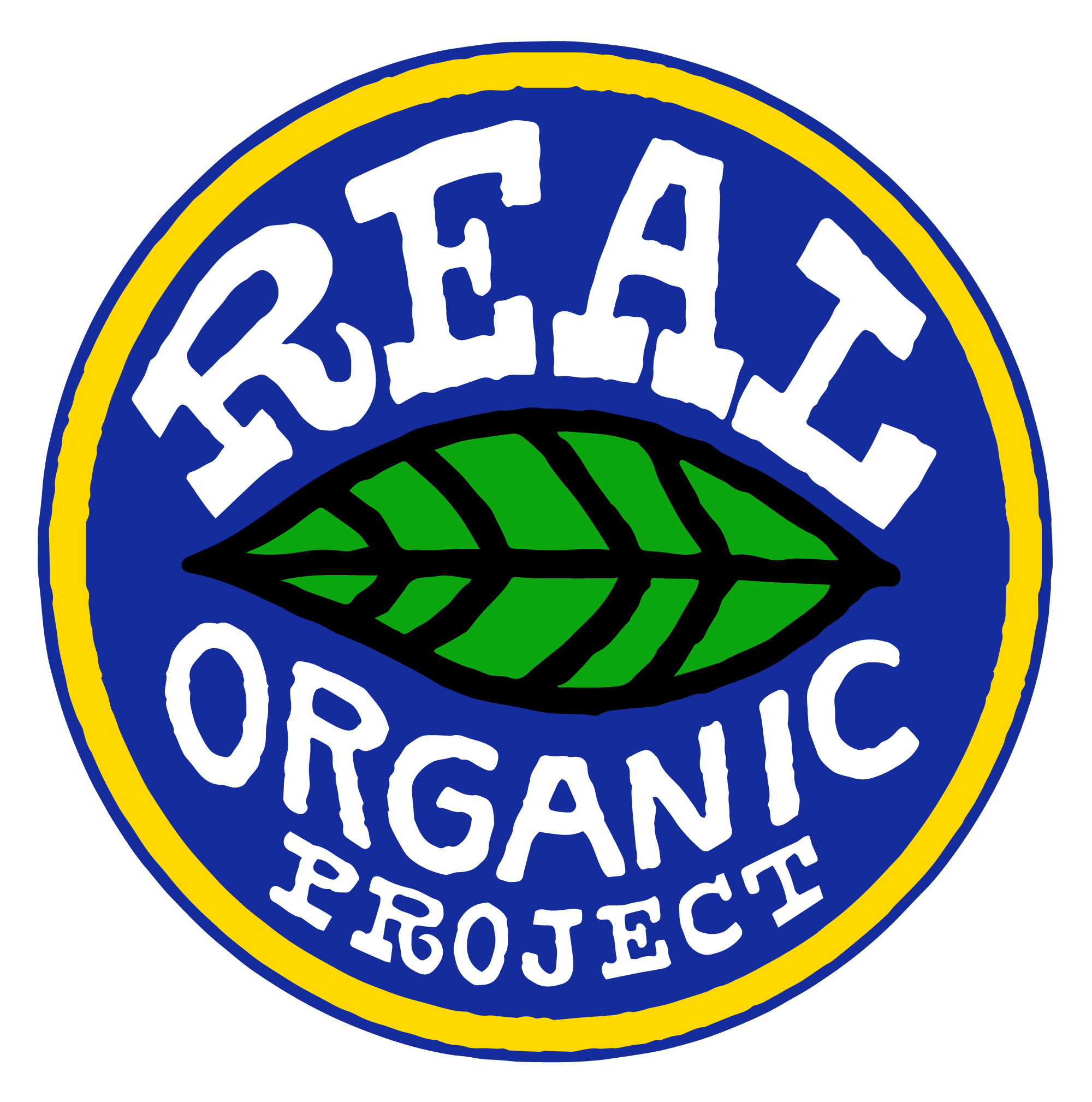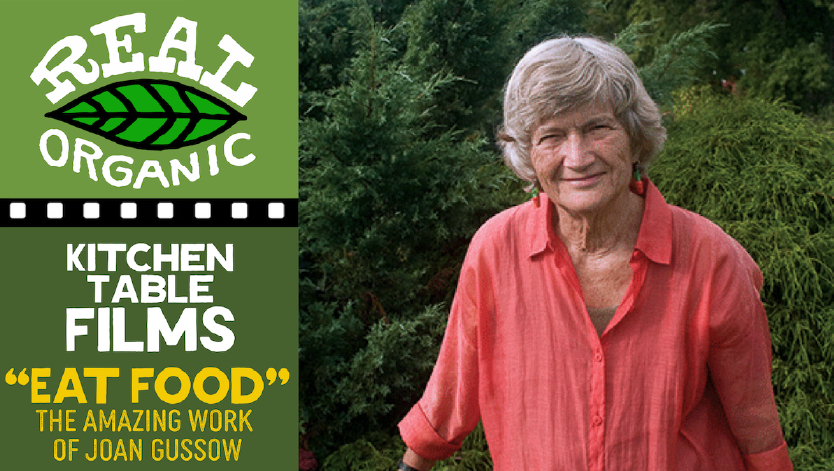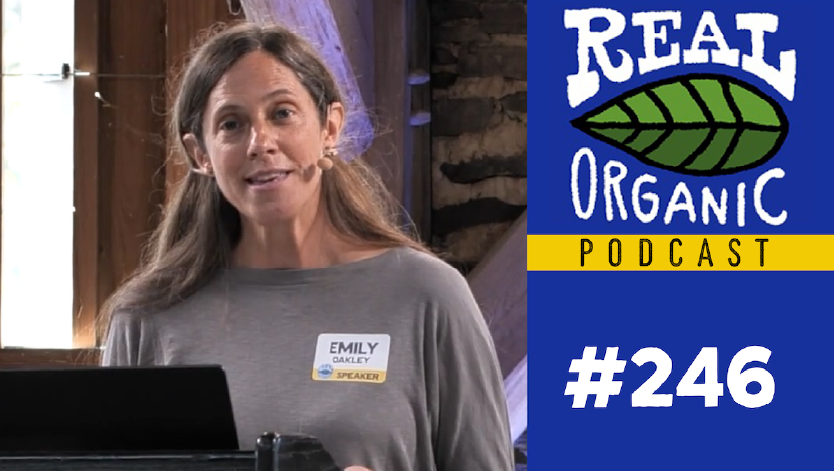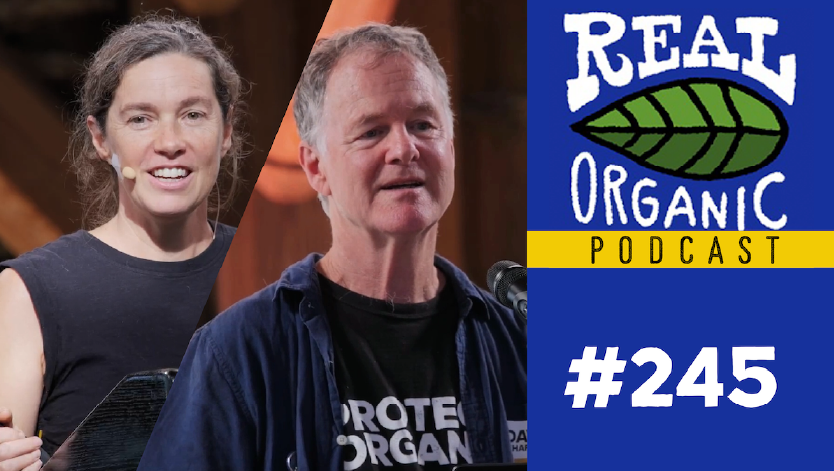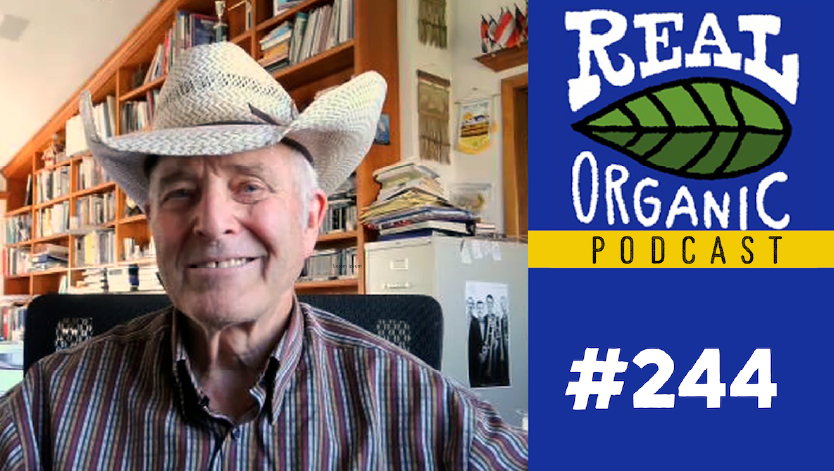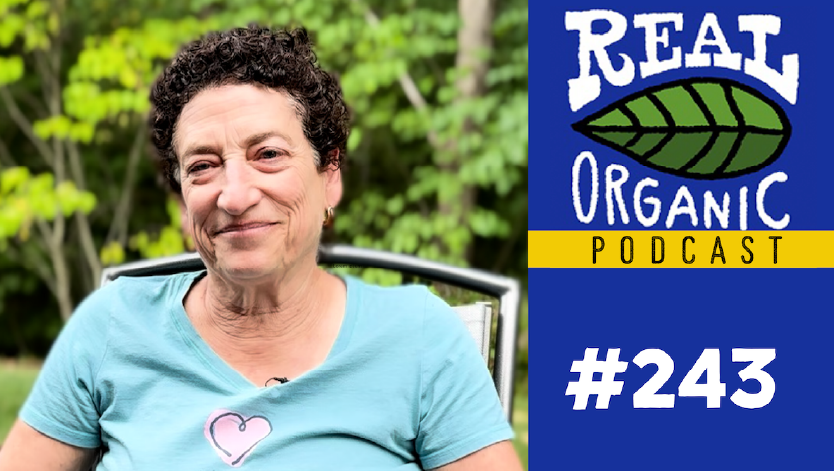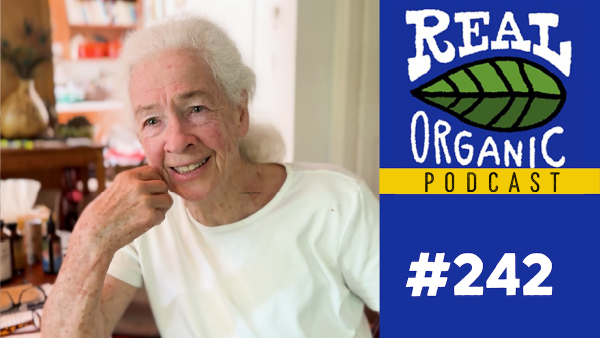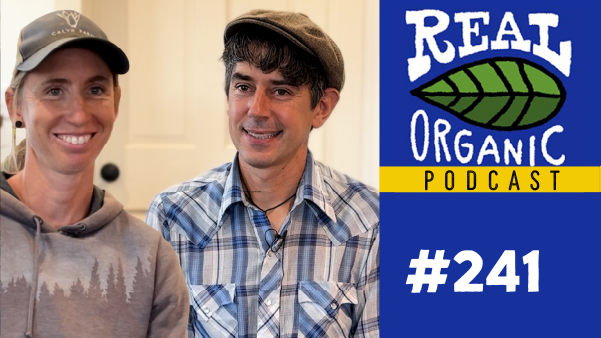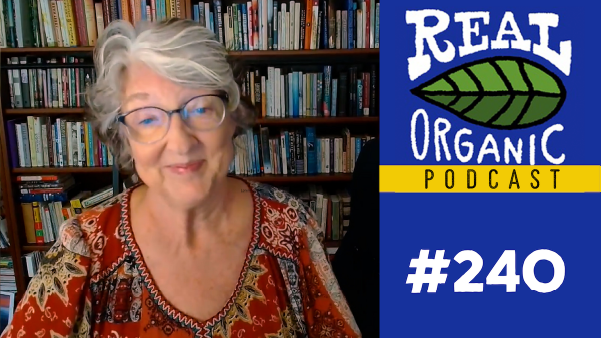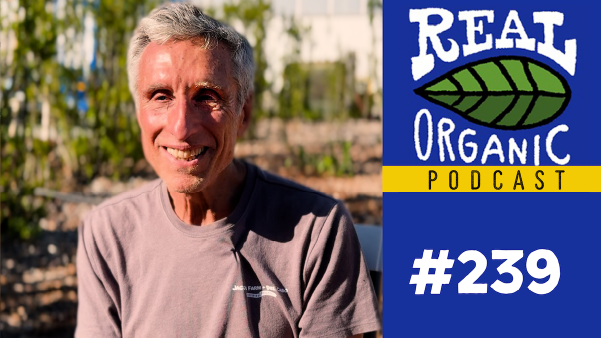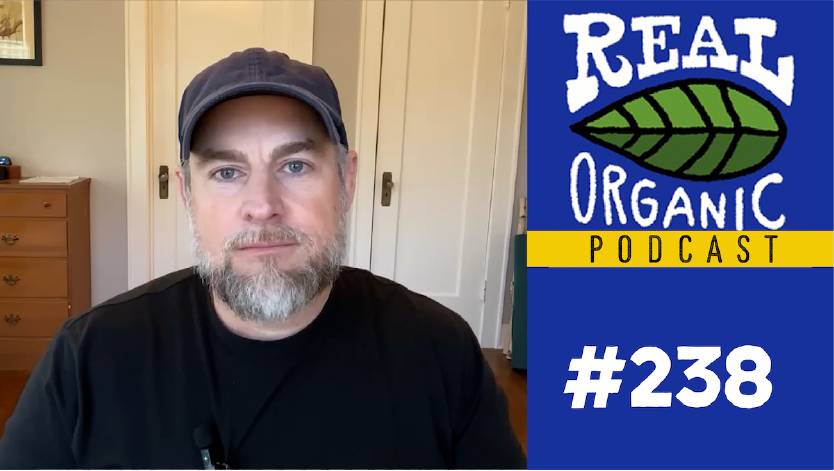Episode #156
Tim Bowles Part 1: Digging Into The Rhizosphere
Welcome! You can subscribe and download episodes of our show through your favorite podcast app.
You can also subscribe to receive the video version of each episode on our YouTube channel.
Our Tim Bowles interview has been edited and condensed for clarity.
Linley Dixon interviews Tim Bowles:
Linley Dixon 0:00
I’m here with Tim Bowles. He’s the professor at UC Berkeley and agro ecology. And, Tim, I’m gonna go ahead and let you describe everything you do at Berkeley, and maybe some of your research interests as well.
Tim Bowles 0:13
Sure. Well, first of all, thanks so much for having me here Linley, It’s a real honor and pleasure to be talking with you and about the real organic project. So as you mentioned, I’m a faculty member, a researcher, teacher at UC Berkeley, and I run the Berkeley agro ecology lab. And we do research on a variety of topics, everything from sort of trying to understand the rhizosphere, or this zone around the roots, that is this hotspot of kind of interactions between soil organisms and plants, and how agricultural activity affects that all the way up to really doing more interdisciplinary work about how different types of state or federal policies are affecting organic farmers in particular, and the opportunities or barriers that they might face to using different systems or practices, and then how that translates back into their soil ecosystems. So the soil is that is kind of the main lens that we have in our research and trying to work in organic agriculture. But we’re always trying to put that in the context of this of this bigger system.
Linley Dixon 1:35
It’s so wonderful to see this being such a sexy topic right now, I did my research in an organic research lab at the West Virginia University. At the time, there were only a couple of universities that were studying organic agriculture. And so kind of describe how the landscape has shifted, it was really rare. And I still had to take all the conventional, I mean, I had to take all the pesticide classes, and I was in the regular agronomy department and we were just kind of the weirdos over there in the organic department. But you know, it was around the time of the USDA creating standards. And that’s why it was acceptable then to actually have some organic research so maybe to talk a little bit about, and maybe there’s still some of that animosity there towards organic agriculture, I don’t know, how fringe is it now?
Tim Bowles 2:21
Yeah, that’s a really good question. And I think it’s going to vary a lot depending on where you are. And I feel very lucky to be here at UC Berkeley that has a really long history of both agro ecology with my colleague, now retired Miguel Thierry and, and even during his time, and before that, we had a division of biological control here, a whole department that was focused on ecological pest management, and really understanding the ecology of agricultural systems, and helping working with farmers to develop alternatives to pesticides. You know, that’s been that department has disappeared. And it has been part of this, I think, broader shift away from, you know, maybe understanding alternatives to our conventional agriculture. But we have this little vestige still remaining here at UC Berkeley, where this, I think, this is accepted. And, and it’s valued.
Tim Bowles 3:27
And, and certainly, I have, we have colleagues across, you know, land grant universities all over the country that are doing great work in this area, but I think you’re right, in that it’s still, even now, I think it’s still not the mainstream in terms of land-grant university kind of agricultural research. But at the same time it’s gaining, I think, more acceptance in the academic world where there’s this recognition, and it’s coming, you know, why did it take so long, but it’s coming, you know, we can do, we can understand the ecology of agricultural systems, just like any other ecosystem, and there’s amazing life and interactions happening in these ecosystems. And so, from an academic perspective, right, it’s becoming more acceptable to do work in these in organic. And of course, it shouldn’t have taken the sort of academic powers that be to sort of give their stamp of legitimacy on it, but it is. I do think it’s something that’s changing.
Linley Dixon 4:39
Yeah, it’s taken a while, but it’s exciting and I loved, how many grad students do you have working at the lab? I loved meeting some of them last time I was there.
Tim Bowles 4:45
Yeah, right now I have four PhD students, two that are kind of close to finishing, two that are just starting out, and then I also have postdocs in my lab, which are folks who have finished their PhDs and are doing, you know, kind of like a residency if you’re, you know, trying to become a physician, but some time after their PhD is done when they’re really focusing on research.
Linley Dixon 5:09
Yeah and what was so exciting was that they were doing research on a lot of the farmers that we know that are part of the real organic project and looking at their systems and trying to give them answers about their soil and what’s going on. When I first met you and wanted to interview you is after your eco farm talk, just last January, and there they put you in too small of a room, there were like farmers all standing in the back. And then there were some, like lined out the door that couldn’t get in. I was wondering if you could just give an overview because it was so good. What you talked about that day, because I was really moved and excited about what you were finding?
Tim Bowles 5:45
Yeah, sure.
Linley Dixon 5:47
If you can remember.
Tim Bowles 5:48
Yeah, no, I absolutely remember, I mean, these are topics that are really near and dear to my heart, but also, you know, our central focus of our labs work. And so this was a presentation where we were really trying to share about all of the interactions between plants and soil and microbes that affect how plants access, nutrients and water. And also, then how does our agricultural management either hinder or support these interactions. And so, you know, it’s a good reminder that like, and I don’t think I’m preaching to the choir here, in terms of I’m sure you’re the folks listening that, you know, soil is absolutely like bursting with life, right. There was actually a recent study that came out that showed that 60% of the world’s biodiversity exists below ground. So if we added up all of the taxa, all of the microbes, all of the plants, all of the animals, all of the world’s life, 60% of those species, either live exclusively in or are deeply rooted in, in the gut and a sense of plants, our soils.
Tim Bowles 7:09
So this is like, this is more diverse than a tropical rainforest, in terms and especially when we look at the microbes that are living there, the bacteria, the fungi, the archaea. And so one of the groups of organisms that we focus on a lot in my lab, and I think, for good reason, sort of have some star power are what are called arbuscular mycorrhizal fungi, or I might, for brevity, I’ll just say, AMF sometimes. But these are fungi, that it’s a group of soil organisms, group of soil fungi that have a very intimate relationship with plants. In fact, they cannot complete their lifecycle without associating with plant roots. So this is what’s called an obligate biotroph. So obligate meaning, like they have to, and biotroph meaning like, you know, associating with something living as part of their, the way that they eat. And this, these organisms, formed a relationship with plants like 500 million years ago and they, we actually think that they are what helped plants actually moved from living exclusively in the water to being able to exist on land. And they, what they do is they they help plants acquire nutrients through their wide network of hyphae that extend out into soil and get all ill into little soil pores inside of little aggregates and then they actually grow inside of plant roots as well, and it’s in there where this really dynamic exchange starts to happen with plant roots.
Tim Bowles 9:14
The plant, it’s, you know, it’s this photosynthesis machine, it’s using the energy of sunlight, to create energy in the form of like carbohydrates and other types of carbon containing compounds. And it kind of shuttles that down into its roots helps feed these AMF, the AMF in turn, they go out, they scavenge up nitrogen or phosphorus and they deliver it back to the roots. So this, you know, this is a super interesting and very mysterious in some ways, group of organisms that, you know, we’ve really just scratched the surface in terms of our ecological understanding of what they’re doing.
Linley Dixon 10:03
When you were speaking, you started talking about the streaming that kind of even goes on outside. So I had never thought of that there’s, you know, cytoplasmic streaming like inside the fungi. But then you talked about maybe quicker movement of water and nutrients outside the fungal hyphae.
Tim Bowles 10:24
Yeah!
Linley Dixon 10:25
Which I though was really fun.
Tim Bowles 10:26
Absolutely, yeah. So this was some really recent research. You know, we’ve, there’s always been a notion that well, AMF, they might in some contexts, they might help plants, access water or help deal with low water situations and there were lots of ideas out there about how they did this. And some of them were kind of indirect. In fact, there was some folks who thought, well, AMF aren’t really moving water itself, they’re not really helping plants acquire water, they’re doing other things that help plants deal with low water situations. But recently, there was a study, that was a really cool experiment, that was able to show that instead of water flowing within these hyphae, right, and we have to remember, these hyphae are very, very small, they’re just a fraction of the size of a root, even a fraction of the size of a human hair, very, very tiny. That instead of water moving on the inside of these hyphae, the water was actually moving along the surface, along the outside of the hyphae.
Tim Bowles 12:25
And so as these little hyphae, were getting into these little tiny soil pore spaces, where there even can exist water, even when the soil overall is pretty dried, the sort of suction that’s created from plant roots can almost pull this water along the surface of these hyphae And if we think about soil, you know, there’s a lot of gaps, there’s a lot of pore spaces if we’re thinking down in these really tiny areas. And what the hyphae are doing is sort of helping to move water from a little tiny wet spot toward the roots and crossing some of these drier pore spaces that water wouldn’t be able to cross otherwise. And so it was some of the first ecological research that was showing that, yes, actually, AMF do have a role in transporting water towards plants, but it’s happening on the outside of the hyphae probably not on the inside. So super fascinating work.
Linley Dixon 12:42
Because first, we were just seeing that if you had crops that had these mycorrhizal fungi, that they were able to survive drought better.
Tim Bowles 12:49
Thats right.
Linley Dixon 12:50
And so we’re trying to figure out why that is.
Tim Bowles 12:52
Exactly, right. And this is one clue to that, I think that there are some other ways, you know, and other experiments that we’ve done, sometimes we use this little model system that we have where it’s, we have a tomato, it’s a determinate variety of a tomato, like aroma style, paste tomato. And we have, you know, this kind of normal wild type version of it. And then there’s a sort of a mutant version of it. This wasn’t created by genetic modification or anything like that, but it was sort of created, just happened to pop up in a research context. And it has a mutation and a couple of genes that makes it mostly unable to form mycorrhizal associations. And so we can plant this wild type tomato, and then this other this kind of mutant tomato that is other way and all other ways is very similar. We can actually plant them side by side, under we’ve done this actually on organic farms in Yolo County, California and hear around in the Bay Area, and then really be able to ask, what is what are AMF doing? Right?
Tim Bowles 14:09
Because we have the wild type and then we have this very closely related genotype that that doesn’t form mycorrhizal associations. And what we’ve been able to show up here in California where you know, any California listeners will know, like water is always a concern. All of our summers are always dry. We’ve been able to show that and these when there are mycorrhizae present, the plants are really changing the way that they are photosynthesizing and transpiring. So transpiration is water moving up through plants and then out in the atmosphere it’s you know, and on our mycorrhizal plants these they were really regulating transpiration and the loss of water in a way that was better able to adapt to low water to drier conditions relative to the non-mycorrhizal ones. So, there’s a lot of ways that, and direct transport of water is one of them, but there’s a number of different ways that that mycorrhizal fungi could be helping plants deal with low water with droughts.
Tim Bowles 13:29
Just as a side note, what is this? There’s a single gene that doesn’t allow mycorrhizal formation, what is that gene doing?
Tim Bowles 15:21
Yeah, it’s a collection of a few. So there’s, this really like, intimate kind of cross talk, you know, at the sort of chemical or molecular level that has to happen between a plant root and the fungus in order for basically the plant to kind of allow the fungus to come literally inside the root. These things aren’t hanging out on the surface of the root, they’re actually growing inside root cells. And forming these specialized structures. That’s actually how arbuscular mycorrhizae get their name is these structures that they form inside the cells are called arbuscules. And they look like beautiful little trees, almost. And so for our Spanish speaking listeners, árbol is the word for tree, Latin roots. So arbuscular mycorrhizal fungi, they’re named for that for these super intimate structures that they form.
Linley Dixon 16:17
They’re maximizing the surface area in there so that we can do all that exchange, right?
Tim Bowles 16:21
Exactly. All this surface area in there, so they can get energy from the plant exchange it with nutrients. And so you can imagine..
Linley Dixon 16:28
Plants and fungi both have cell walls, right, so and those are gone too, so we’ve got membrane to membrane, tight, close interactions.
Tim Bowles 16:36
Yeah, exactly and so you can imagine, like, you know, this is a relationship that has formed over millions and millions of years of evolution. And so there’s the, there’s a set of genes that are involved in this kind of molecular level of communication between the plant and the fungus, in order for the plant to say, okay, come on inside, it’s okay, I recognize you. And those are the genes that have been disrupted in this meeting. So just to be clear, this is not something that we are using for, you know, for cultivation. This is this is purely just like a research model system to help us understand what, AMF are doing.
Linley Dixon 17:20
And so do we need to be talking about is it do you pronounce it glomulin or glomalin, when we’re talking about kind of all of that stuff that’s streaming on the outside? Is that part of your research, too?
Tim Bowles 17:31
we haven’t looked too much at glomulin, but it is really important constituent of soil that we think of as helping to glue a lot of soil particles together and help form soil aggregates and soil structure. It’s not something that we’ve looked at too much in my lab, but definitely, in a really important, like product of all of this microbial activity that helps form soil structure.
Linley Dixon 18:00
When I was mostly taught about this, it was phosphorus. That was the big nutrient that was limiting that kind of allowed the plant to say, okay, I need you, because I’m phosphorus deficient. Are there other nutrients that are at play here? I’ve kind of heard recently, some talk of nitrogen, you know, what else is going on?
Tim Bowles 18:19
Yeah, great question. Yeah, historically, phosphorus was the big focus. And this was for good reason in that, if we think of roots, being able to access nutrients and soil, there’s a couple of factors here, we need to think about. One, like what are all the spaces that roots can get to or not, and then how mobile are nutrients in the soil, right? And the forms of phosphorus that plants can access in soil are typically not very mobile, they don’t move very far. And so plants access to them is really limited by where the plant roots can go. And so it kind of makes sense that evolutionarily like the main source of nutrients that plants and AMF are trading is phosphorus, because the hyphae can can explore a lot more of soil than the roots can and help get them access to these more immobile nutrients.
Tim Bowles 19:26
Now, nitrogen on the other hand, you know, the there’s two main forms of nitrogen that plants can access and soil. There’s some exceptions, but they mainly are looking for ammonium and nitrate. Nitrate is very mobile in soil, and I want to say this, this is even in organic systems, right where organic amendments are being added where you’re relying on legumes, all of this organic material right, is being processed in the soil and turned into ammonium and nitrate. Even if those aren’t the fertilizers that you’re adding. So nitrate is a little bit more mobile. So there was some thinking that yeah, this, yeah, AMF maybe aren’t helping too much with this because you know, it’s mobile, it’s going to flow towards plant roots. But what we’ve seen in a number of studies is that we know that AMF can take up forms of nitrogen, particularly ammonium, they can transport it through their hyphae. There are little, sort of these, you know, molecular transporters, these enzymes in the roots that accept ammonium from AMF, so we know that the machinery is there. And in some of our research, using this tomato model system, we’ve shown higher concentrations of nitrogen in the mycorrhizal genotype versus the non-mycorrhizal which, and this is in real field settings, this isn’t in like a greenhouse.
Tim Bowles 21:00
And so we do think that they’re playing a role in nitrogen nutrition, as well, alongside the, you know, the water and the phosphorus. You know, the last thing I’ll mention here is that I think it’s important for all of us to remember that like, if we think evolutionarily like over a long time horizon, and association with AMF is the norm for plants, it’s not the exception. About 80%, 70 to 80%, of terrestrial of land plant species form associations with AMF. So this is really like the norm. So when we’re thinking about all the things that they do, we have to remember that this is like, part of this bigger picture of what a plant is, right? This idea of like the holobiont, I don’t know if that’s a term that’s familiar to anybody, but it’s this idea that we’re not, we can’t think of ourselves as just an individual organism, because our baseline even as humans, thinking about our gut microbes, like our natural our baseline actually is association with all of these other organisms. And the same is kind of true for plants and AMF. This is, with some exceptions, this is kind of their, their normal situation.
Linley Dixon 22:21
Yeah, I love that idea of just you can’t think of yourself, you know, alone without all the life that’s around it. I, there’s so many places I want to go, I do want to kind of figure out the organic farmers have so many different practices. And so there’s I know, you’re kind of trying to take a look at which practices are affecting mycorrhizae and you presented some of those findings that day, so maybe kind of set us up for what you found back then, any new research you have, and questions that you still have.
Tim Bowles 22:55
Sure, yeah. So I want to think a little bit about, because I always like to share a bit about the ecology of these organisms so that it helps us understand how different practices might affect their abundance, their diversity, so how many there are how many different ones there are. And so for instance, one of the practices that we looked at is cover cropping. In an annual cropping system, in the absence of cover crops, there’s typically long relatively, you know, can be fairly long periods where there aren’t many living roots in the ground. And so, as I mentioned, at the beginning, AMF are these, require plants to complete their lifecycle.
Tim Bowles 23:49
They’re not like other fungi that can go and decompose organic matter on their own. They actually don’t do that at all, other AMF are getting all of their energy from living plant roots. So you can imagine, if you have a long time period, with no living roots in the ground, a lot of the living AMF are going to disappear. What’s going to be left are their spores, you know, we can think of spores as one of the ways that AMF propagate themselves, it’s sort of like their seeds, think of it like that. And so what’s going to be left are those spores. And so when something new is planted, those spores are going to have to germinate. They’re going to have to grow towards the roots. They’re not going to form those associations as quickly. And we’re also going to be kind of selecting for types of AMF that can survive these longer periods without plant roots. So it might also affect which AMF taxa, which AMF species are there and potentially their diversity as well.
Tim Bowles 24:58
So that’s something, so in our work on cover cropping, we’ve done what’s called a meta analysis, which is where we look at any study anywhere in the world that has looked at cover cropping, and their effect on the abundance of AMF. And what we see is that there’s about a 30% increase on average across all these different places, in the abundance of AMF with cover cropping. So that’s one practice we’ve looked at. Another PhD student that was in my lab, Aidee Guzman, who’s done just amazing work here with farmers in California who do a lot of polyculture, a lot of intercropping. She was interested in how polyculture intercropping affects the diversity of the mycorrhizae that are present. And found that about twice as many AMF taxa are present, or AMF species are present, when there’s intercropping versus where there’s more monocropping.
Linley Dixon 26:08
And that’s how many is the baseline there? Twice as many from what?
Tim Bowles 26:14
Yeah, it’s in those kind of low dozens. So I mean, interestingly enough, like AMF globally, have a few 100 different taxa, different species. They’re actually not as, I mean relative to other groups of microbes they’re not a super diverse group, but we know that they do different things. We know that they have different traits, they have different functions. And so just like, you know, there’s a general idea and ecology that, well, if you have more diversity around there’s going to be more of a likelihood that those organisms will play different roles or will be adapted to different conditions. And so what we sort of hypothesize here is that more diversity of AMF might mean that those AMF we’ll be able to sort of do a more complete set of functions. Maybe some of them specialize more in phosphorus transport, others maybe you’re better at nitrogen, or some of them like to associate with tomatoes more than they do with grains, right? So think of all these different ways where you might have slight differences in a more diverse community of AMF means that you might be more likely to have a like a more complete set of functions, especially as conditions change.
Linley Dixon 27:42
And in general, these species aren’t very host specific, they have many hosts that they..
Tim Bowles 27:47
Thats right. Yeah, they’re not particularly host specific. That’s a really good question. And we can think about this, like, kind of generally, there are like hundreds of 1000s of different plant species, just in the hundreds of different AMF species, but most plants form associations with AMF. So even just based on that, we can say, oh, yeah, AMF are kind of generalists, they’re not too picky, usually, maybe some, but in general, not too picky about which plants they’re forming associations with.
Linley Dixon 28:22
And in agricultural systems, too is it safe to say that the type of myccorhizae are these AMF and in more forested systems, you’ve got different kinds of myccorhizae that might be there, maybe kind of describe the difference, or maybe it’s not even forested, but more perennialized systems.
Tim Bowles 28:40
Yeah, so there’s, two other groups of mycorrhizal fungi, they’re pretty different. One are called ectomycorrhizal fungi, these are the ones that you find more in forest ecosystems. And they’re pretty different, they don’t actually make it inside the roots of the plants that they’re associated with. They’re kind of hanging out on the outside, so that’s why they’re ecto. AMF are sometimes called endomycorrhizae. Ectomycorrhizae are pretty different, they can decompose organic matter, they don’t have to associate with plant roots. They’re doing some of the same things in terms of delivering nutrients in exchange for energy, but their life history or their, their ecology is a little more flexible. So even in agricultural systems, a lot of our cultivated trees are also AMF dependent, like the Prunus genus, which you know, stone fruit and almonds, and those are AMF dependent. So even in more perennialized systems, in agriculture, I mean, unless you’re really talking about agroforestry systems that have a lot of our cultivated domesticated species are still AMF dependent.
Linley Dixon 30:03
One of the things I learned was that, and I got to play around with them a little bit, if there was too much fertility, and we actually didn’t get those interactions happening, though, the mycorrhizae were not accepted by the tomato plant. Would you say that fertilizers affect whether or not you know these interactions happen? And is there a difference between maybe an organic fertilizer that’s not kind of readily available, versus a synthetic fertilizer? How is that affecting this?
Tim Bowles 30:36
Yeah, that’s such a good question, and we’ve done a bit of research on this. In general, yeah you know, we think of AMF and plants as having a mutualism, as being like one of the best examples of a mutualism right. Mutualism is where, you know, both parties in the interaction benefit, right, plants get their nutrients, AMF get their energy, the world is good. But sometimes, that’s not always the case, right? Mutualism is not always a mutualism, it can be a somewhat context dependent. And one of those important contexts is how much available nutrients are there. So you can imagine from a plant’s point of view, well, if they’re in a situation in a soil, where there’s a whole lot of available nutrients, a whole lot of available phosphorus, a whole lot of available nitrogen. Well, they can get a lot of the nutrients they need, just from their roots, so why spend all this energy this on on the mycorrhizae.
Tim Bowles 31:43
And so plants have some control and the fungus have some control, but plants can sort of like, down regulate or sort of prevent some of the associations from happening in really well fertilized contexts. And that can ultimately affect the extent to which plants receive benefits or we get an increase in say, productivity with AMF. Phosphorus is probably the most studied example of this, and we actually did an experiment at a long term research trial that was happening at UC Davis, and this research trial had been going on for about well, almost 25, 26 years when we were working on it, and it’s a trial that compares an organic tomato, corn rotation, which is relatively common in that part of the Sacramento Valley. It has cover crops, it’s a tilled system with a conventional tomato, corn rotation, a lower synthetic input, but still some synthetic inputs, tomato, corn rotation that included cover crops, and then an extended kind of tomato, corn, alfalfa rotation. And we planted this our tomato model system, you know our mycorrhizal and our non-mycorrhizal genotypes across each of these farming systems to say, okay, well what’s the effect of this like 25 year history on the way that AMF were functioning with plants?
Tim Bowles 33:27
Was it all no-till?
Tim Bowles 33:35
The conventional, they were all tilled.
Tim Bowles 33:39
Tilled. So there wasn’t like a no-till..
Tim Bowles 33:42
There wasn’t a no-till component to this, it was really about, you know sources, you know, organic or not so like sources of fertility and pesticides, and then with or without cover crop, and then this extended rotation with three years of alfalfa. And we were really surprised we went into this thinking, obviously, the organic system, it’s going to have the most mycorrhizae that you know, they are going to play the biggest role in helping plants produce biomass and tomato yield. And we were really surprised to see that there was almost no difference in growth between the mycorrhizal on the non-mycorrhizal genotype in the organic system, suggesting that AMF weren’t really playing much of a role, they weren’t hindering plant growth, but they also weren’t helping very much. So we were looking at yields as kind of the, just the ultimate outcome here. Where we saw the most benefit was in this rotation, and also the highest tomato yields was in this corn, tomato and extended alfalfa rotation.
Tim Bowles 34:45
And so we were trying and sort of intermediate benefits in the conventional and the lower input. So we were really scratching our heads about this, like what is going on? And we started looking at levels of available phosphorus in soil. And that’s where we started to get some clues. The organic system had, by a pretty wide margin, the highest levels of phosphorus, we were using measure of available phosphorus called Olsen phosphorus, other states use Mehlich, or there’s different extractions that you can do to measure available phosphorus. And this really came from a history of using a lot of poultry manure in the organic system, and basing the rate of poultry manure additions on plant nitrogen needs. And so poultry manure has a relatively low ratio of nitrogen to phosphorus. So what was happening was with the history of poultry manure applications, there was kind of more phosphorus being added to the organic system then was actually needed. So levels of soil phosphorus were building up. So what we ultimately think happened is like this high level of phosphorus fertility was causing plants to say, you know what, I don’t really need the mycorrhizae as much.
Linley Dixon 36:11
Yeah.
Tim Bowles 36:13
And so it’s a good reminder around unintended consequences of our of our management, right. And, of course, we’re always, you know, folks are making decisions for a whole variety of reasons. But it’s just a good reminder about potential unintended consequences and the complexity of some of this ecology that’s happening.
Linley Dixon 36:38
Okay, so many questions about that one, we’re running out of time. We might have to do a two part interview.
Tim Bowles 36:44
Sure, it’s been a really fun conversation.
Linley Dixon 36:46
I went to Washington, DC, and you know, I was lobbying for organic to be more supported in the Farm Bill. And across the board, it was like organic is not climate smart, you guys till. And my experience across the country is that the best organic farmers were actually growing these huge cover crops, and, I mean, in California there’s, you know, Full Belly and I know that they maybe were part of some of these experiments, Phil Foster and
Tim Bowles 37:14
That’s right, yeah.
Linley Dixon 37:16
Yeah, just the kind of reduced tillage, they were trying playing around with no-till, but it was really difficult for them. But even across the country, you know, in the Midwest, where it rains more, Mark Askegaard produces grain, and you know, he’s growing all his own fertility he doesn’t use any off products.
Tim Bowles 37:34
Yeah, that amazing.
Linley Dixon 37:35
He’s doing that with cover crops, and same thing with this woman, Emily Oakley, who’s been to EcoFarm, Three Springs Farm. So for me these were the best farmers, are growing their own fertility in the form of cover crops, they’re well mowing maybe, somehow incorporating often quite deeply. To me, I was like, this is the best kind of farming there is. But we have this real difference of opinion, I think there’s a lot of people with really good intentions that are saying that that kind of farming is not good, because you till and you’re destroying mycorrhizae, and I’m just you know curious, even if it’s once a year and you’re incorporating that cover crop, I’m thinking those spores, those mycorrhizal spores are surviving, that.
Tim Bowles 38:17
They are, they are surviving that.
Linley Dixon 38:19
Different from like a tillage or an herbicide burned down, right? Maybe even more beneficial because the mycorrhizae, do we even know how they’re affected by herbicides? We certainly know from fertilizers, it’s not great.
Tim Bowles 38:31
Yeah. And I think, well just to start with your first question. Yeah, the spores are surviving tillage, right. Your mycorrhizae are not going to disappear from a tilled system. And that same global meta analysis that I mentioned where I talked about cover cropping, we also looked at reduced tillage and no-till, and you do see a similar increase in abundance that you do with cover cropping when you move to reduced or no-till, about a 30% increase in abundance of AMF. But at the same time, in the cover crop systems that had tillage, you also saw the benefits of cover cropping. So, my point is, there are kind of multiple ways of getting at similar kind of outcomes. From a strictly mycorrhizal standpoint, you know the combination of roots in the ground and minimal disturbance is probably the best.
Tim Bowles 39:37
But at the same time you know the predominant forms of notes hill that we have in this country are all herbicide and you know, transgenic based with herbicide with resistance to Roundup. So, I think of those no-till systems as being kind of a different category, you know, in the sense of like, we need to look at the trade offs of that, and not to get too hung up on, and for organic farmers not to get too hung up on the soil disturbance that they do have to do. I’m not worried about mycorrhizae disappearing from those farms, and for instance on the just going on long winded here, but the farms that Dr. Aidee Guzman was also working on comparing polyculture and monoculture of vegetable systems, those are all till based systems.
Tim Bowles 40:32
So even in the background of tillage, you know, we saw this big increase in diversity with AMF, and so it’s not as if tillage is really the wiping these organisms out, I do not think that’s that’s the case. And the last thing I’ll add, is maybe getting a little bit on a soapbox here, is I think the more we learn about the perceived or purported climate benefits of no-till agriculture, I think the more we kind of raise some questions about it, nd I’m really referring to the sort of more widespread herbicide base no-till that we see out there. There had been a lot of excitement that oh, yeah, and it kind of makes sense that no-till would increase soil carbon and have climate benefits from that way. But that was a result of a lot of studies that only measured to change in soil carbon in the top six inches or foot of soil.
Tim Bowles 41:37
So as we have more studies that dig much deeper, and get down to the top three feet or more of soil, what we’re really seeing is not much of a difference and a lot of places with no-till versus till in terms of soil carbon. What’s really happening is that there’s kind of a redistribution of soil carbon meaning in a tilled system, we had a concentration of carbon at the surface, and then actually somewhat less carbon a little bit deeper. And with the tilled system, we get a little less carbon at the surface and a little more deeper. So the story around climate benefits and kind of herbicide based no-till is…. I’m not super convinced about, and I think others are also raising some questions about that.
Linley Dixon 42:23
Well we’ve got our work cut out for us because they’ve done a good job in Washington, DC, convincing everybody organic farmers are the problem. Are you open to another, part two?
Tim Bowles 42:34
Yes.
Linley Dixon 42:34
Because I still have more questions.
Tim Bowles 42:35
Yeah, absolutely. Let’s do it again. This has been a really fun conversation.
Linley Dixon 42:38
Oh good, okay. Yeah, no, I’ll honor your time, and we’ll figure out another time to continue the story. Thank you so much Tim.
Tim Bowles 42:44
Alright thanks Linley. Ok.
Linley Dixon 42:45
Bye bye.
